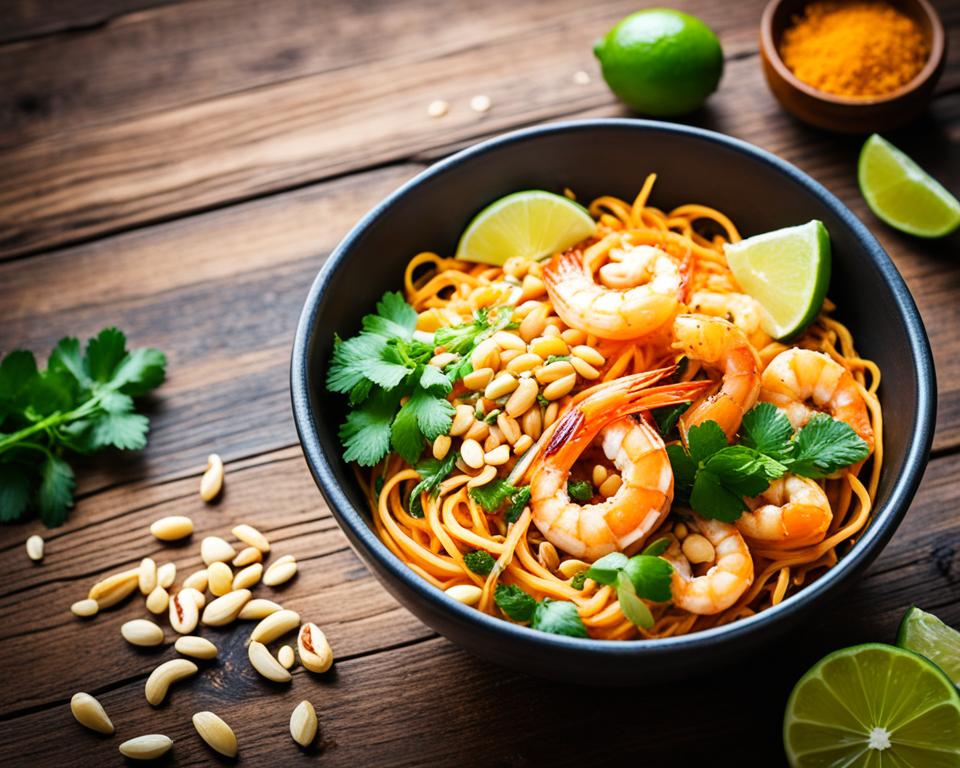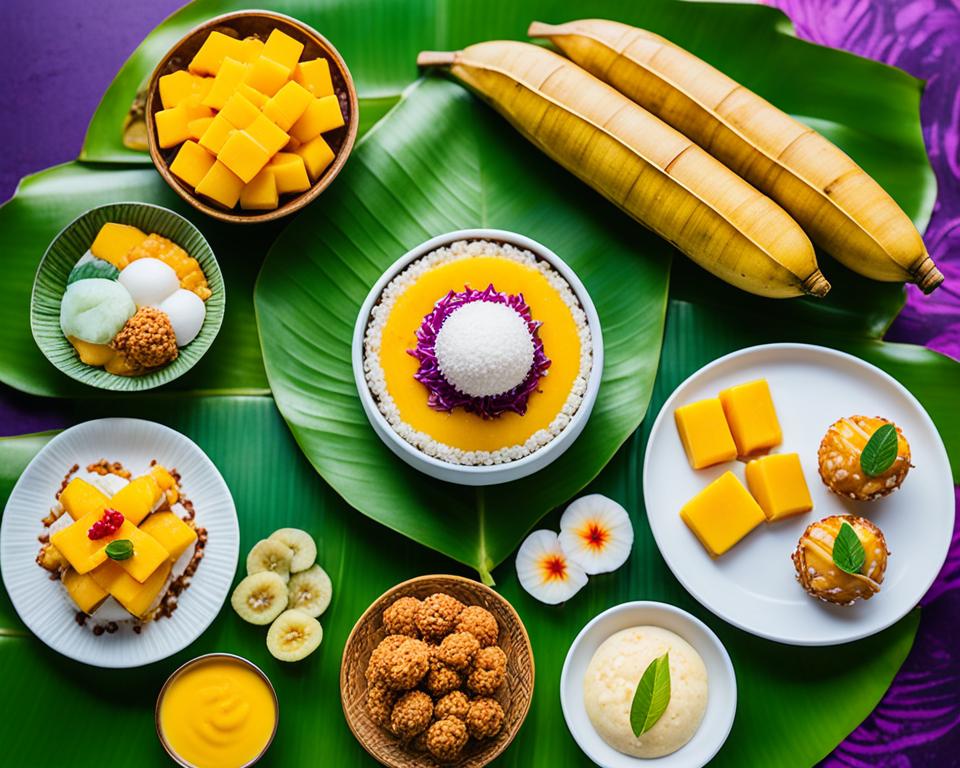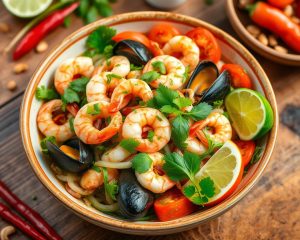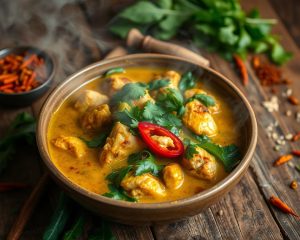Discover the Art of Delicious Thai Cuisine Near You

Thai cuisine is renowned for its bold, vibrant flavors that captivate the senses. From the bustling streets of Bangkok to the tranquil countryside, the art of delicious in Thai cooking has been refined over centuries, resulting in a diverse and fascinating culinary landscape. In this article, we will embark on a journey to unveil the secrets of Thai cuisine, explore its regional specialties, and discover the best local restaurants near you that offer an authentic taste of this beloved culinary tradition.
Unveiling the Secrets of Thai Cuisine
Thai cuisine is renowned for its bold, vibrant flavors that captivate the senses. From the bustling streets of Bangkok to the tranquil countryside, the art of Thai cooking has been refined over centuries, resulting in a diverse and fascinating culinary landscape. Thai cuisine is characterized by its unique balance of five fundamental tastes: sweet, sour, salty, bitter, and spicy. This intricate harmony of flavors is achieved through the careful selection and combination of fresh herbs, spices, and ingredients.
Exploring the Unique Flavors of Thai Cooking
At the heart of Thai cuisine lies the delicate interplay of various aromatic herbs, such as lemongrass, kaffir lime leaves, and Thai basil. These ingredients, combined with an array of spices like chili peppers, galangal, and cumin, create the signature flavors that define this culinary tradition. The balance of these elements is paramount, as they work in harmony to produce dishes that are both delicious and visually appealing.
Understanding the Influence of Thai Culture on Cuisine
Thai cuisine is deeply rooted in the country’s rich cultural heritage, reflecting the diverse regional influences and traditions that have shaped its evolution over time. From the curries of the North to the seafood specialties of the South, each aspect of Thai cooking is infused with the unique flavors and ingredients of its respective locality. This cultural diversity not only contributes to the depth and complexity of Thai cuisine but also showcases the ingenuity and adaptability of its culinary masters.
delicious in thai
At the heart of Thai cuisine lies the concept of “delicious in thai,” which emphasizes the importance of creating dishes that are not only visually appealing but also bursting with complex and harmonious flavors. This culinary philosophy is evident in the vibrant and diverse street food scene across Thailand, where vendors skillfully prepare a wide array of dishes that showcase the country’s rich culinary heritage.
The Authentic Taste of Thai Street Food
Wandering through the bustling streets of Thailand, you’ll be captivated by the sights, sounds, and tantalizing aromas of the local street food vendors. From the sizzling woks of Pad Thai to the fragrant curries and mouthwatering grilled skewers, these humble eateries offer a glimpse into the true essence of delicious in thai cuisine. Each dish is prepared with a meticulous attention to detail, blending the perfect balance of อร่อย, เมนูอาหารไทย, and อาหารรสชาติดี.
Mastering the Art of Balancing Flavors in Thai Dishes
The success of Thai cuisine lies in its ability to skillfully balance the five fundamental tastes: sweet, sour, salty, bitter, and spicy. This intricate harmony is achieved through the careful selection and combination of สูตรอาหารไทย, วัตถุดิบคุณภาพ, and เครื่องเทศไทย. Every bite of a well-crafted Thai dish is a journey of รสชาติเข้มข้น, where each flavor complements and enhances the others, resulting in a truly อาหารท้องถิ่น experience.
Essential Ingredients in Thai Cooking
The foundation of Thai cuisine lies in the exceptional quality and diversity of its ingredients. From the vibrant, aromatic herbs and spices to the creamy and versatile coconut milk, these elements play a crucial role in shaping the distinct flavors and textures of Thai dishes.
The Role of Fresh Herbs and Spices
At the heart of Thai cooking is the masterful use of a wide array of fresh herbs and spices. Ingredients such as lemongrass, kaffir lime leaves, galangal, and Thai basil lend their unique aromas and flavors, creating a harmonious symphony of tastes that defines the อร่อย (delicious) character of Thai cuisine. These vibrant elements not only enhance the visual appeal of Thai dishes but also contribute to the depth and complexity of their รสชาติเข้มข้น (intense flavors).
Discovering the Versatility of Coconut Milk
Another essential ingredient in Thai cooking is the คุณภาพ (quality) coconut milk, which adds a rich, creamy texture and a subtle sweetness to a wide range of dishes. From the iconic เมนูอาหารไทย (Thai menu items) like curries and soups to desserts and sauces, coconut milk is a versatile ingredient that helps to balance the อาหารรสชาติดี (flavorful) profiles of Thai cuisine. Its ability to seamlessly blend with a variety of เครื่องเทศไทย (Thai spices) and อาหารท้องถิ่น (local ingredients) makes it an indispensable component in the ร้านอาหารไทย (Thai restaurants) and สูตรอาหารไทย (Thai recipes).
Regional Specialties of Thai Cuisine
Thai cuisine is remarkable for its regional diversity, with each part of the country boasting its own distinct อาหารท้องถิ่น and culinary traditions. From the fiery เครื่องเทศไทย-infused curries of the เมนูอาหารไทย North to the tangy รสชาติเข้มข้น salads of the Northeast, and the fragrant อร่อย seafood dishes of the South, the breadth of Thai cuisine is a testament to the country’s rich cultural heritage and the ingenuity of its people.
The northern region of Thailand is known for its robust and complex flavors, often showcasing the use of วัตถุดิบคุณภาพ such as อาหารรสชาติดี lemongrass, galangal, and kaffir lime leaves. Dishes like สูตรอาหารไทย Khao Soi, a rich and creamy coconut curry noodle soup, and Laab, a spicy minced meat salad, are prime examples of the region’s culinary prowess.
In the Northeast, or Isaan, the cuisine is renowned for its ร้านอาหารไทย bold and tangy flavors, with a heavy emphasis on fresh herbs, เครื่องเทศไทย chili peppers, and fermented ingredients. Som Tam, the iconic อร่อย Thai papaya salad, and Larb, a spicy minced meat salad, are two of the region’s most celebrated dishes.
The southern regions of Thailand, meanwhile, offer a อาหารรสชาติดี treasure trove of seafood-centric dishes that showcase the bountiful coastal resources. From the aromatic วัตถุดิบคุณภาพ Massaman curry to the fragrant and รสชาติเข้มข้น Phat Phong Lai (stir-fried squid with turmeric and shallots), the South’s culinary offerings are a delightful blend of เมนูอาหารไทย land and sea.
By exploring the ร้านอาหารไทย distinct regional specialties of Thai cuisine, one can truly appreciate the depth and diversity of this captivating culinary tradition, which continues to enchant and delight food enthusiasts around the world.
Legendary Thai Curries and Their Origins
Thai curries are renowned worldwide for their rich, complex flavors and the incredible depth of their spice blends. These legendary dishes have a storied history, with each variety tracing its origins to specific regions and cultural influences within Thailand.
The Allure of Thai Red Curry
One of the most iconic and beloved Thai curries is the อร่อย red curry, known for its vibrant crimson hue and its รสชาติเข้มข้น bold, spicy-sweet taste. Originating from the central region of Thailand, this curry’s unique flavor profile is the result of a harmonious blend of เครื่องเทศไทย lemongrass, galangal, kaffir lime leaves, and a blend of อาหารรสชาติดี aromatic spices that come together to create a truly captivating culinary experience.
Mastering the Complexity of Thai Green Curry
In contrast to the fiery red curry, the เมนูอาหารไทย Thai green curry is prized for its อร่อย complex and nuanced flavors. Hailing from the northern regions of Thailand, this curry features a vibrant green hue and a harmonious blend of วัตถุดิบคุณภาพ fresh herbs, aromatics, and สูตรอาหารไทย a unique curry paste that imparts a distinct herbal and slightly sweet taste. The ร้านอาหารไทย authentic preparation of this curry requires a careful balance of ingredients and techniques to achieve the perfect balance of flavors.
Pad Thai: The Iconic Thai Noodle Dish
Pad Thai, the iconic stir-fried noodle dish, is arguably the most well-known and beloved representative of Thai cuisine around the world. This culinary masterpiece has a rich history that can be traced back to the mid-20th century, when it became a national dish and a symbol of Thai cultural identity.
Unraveling the History of Pad Thai
The origins of Pad Thai can be attributed to the influence of Chinese and Thai cultures, with the dish evolving over time to incorporate local ingredients and regional flavors. During the 1930s, the Thai government, under the leadership of Prime Minister Plaek Phibunsongkhram, promoted the dish as a way to build national pride and showcase the delicious in thai cuisine to the world.
Pad Thai’s rise to fame was further accelerated by its accessibility and adaptability, making it a popular choice for street food vendors and home cooks alike. The dish’s balance of sweet, sour, salty, and spicy flavors, combined with its vibrant colors and satisfying texture, have captivated the hearts and taste buds of Thai food enthusiasts around the globe.
Perfecting the Art of Stir-Frying Pad Thai
Crafting the perfect Pad Thai requires a deep understanding of the art of stir-frying and the careful selection of high-quality ingredients. From the thin, chewy rice noodles to the aromatic blend of garlic, shallots, and chili, each component plays a crucial role in creating the dish’s signature complex flavors and satisfying textures.
Mastering the technique of stir-frying Pad Thai involves a delicate balance of timing, temperature, and technique, allowing the chef to caramelize the flavors, evenly distribute the ingredients, and achieve the perfect level of doneness. This attention to detail, combined with the use of fresh, local produce and the judicious application of fish sauce, lime juice, and palm sugar, ensures that each bite of Pad Thai is a culinary delight.

Som Tam: The Refreshing Thai Papaya Salad
Som Tam, the vibrant and refreshing Thai papaya salad, is a beloved dish that showcases the country’s masterful use of fresh, seasonal ingredients and the perfect balance of flavors. Originating from the Isaan region in northeastern Thailand, Som Tam has become a quintessential part of Thai cuisine, often served as a side dish or a light, refreshing starter.
Exploring the Tantalizing Flavors of Som Tam
At the heart of Som Tam lies the shredded green papaya, which provides a crunchy and subtly sweet base. This is then combined with a vibrant blend of chilies, lime juice, fish sauce, tomatoes, peanuts, and various herbs. The result is a tangy, spicy, and refreshing salad that perfectly captures the essence of Thai flavors.
The key to a successful Som Tam lies in the careful balance of the ingredients. The sour and salty notes from the lime juice and fish sauce are expertly balanced by the sweetness of the papaya and the crunchiness of the peanuts. The heat from the chilies provides a thrilling contrast, while the aromatic herbs like cilantro and mint lend a refreshing and fragrant touch.
Whether enjoyed as a standalone appetizer or as a complementary side dish to pair with grilled meats or spicy curries, Som Tam is a true culinary delight that captures the essence of Thai อร่อย cuisine.
Thai Desserts: Sweet Indulgences to Savor
Thai cuisine is not only renowned for its savory dishes but also for its exquisite and diverse range of desserts. From the beloved mango sticky rice to the delightful coconut-based treats, Thai sweets offer a delectable journey through the country’s rich culinary heritage.
Mango Sticky Rice: A Beloved Thai Treat
One of the most iconic Thai desserts, mango sticky rice, is a heavenly combination of sweet, ripe mangoes, fragrant sticky rice, and a creamy coconut milk sauce. This beloved treat is a true embodiment of the อร่อย (delicious) flavors that Thai cuisine is renowned for. The perfect balance of sweetness, texture, and รสชาติเข้มข้น (intense flavor) makes mango sticky rice a must-try for any เมนูอาหารไทย (Thai food menu) enthusiast.
Discovering the Delights of Thai Coconut Desserts
Coconut is a versatile and beloved ingredient in Thai ร้านอาหารไทย (Thai restaurants), and it shines brightly in the country’s diverse range of desserts. From the creamy khao niaow ma muang (coconut sticky rice with mango) to the delicate khanom chan (layered coconut pudding), these อาหารรสชาติดี (delicious-tasting dishes) showcase the mastery of Thai สูตรอาหารไทย (Thai cuisine recipes) in blending วัตถุดิบคุณภาพ (high-quality ingredients) to create อาหารท้องถิ่น (local specialties) that are both เครื่องเทศไทย (Thai spices) and รสชาติเข้มข้น (intensely flavorful).

Authentic Thai Restaurants Near You
For those seeking to immerse themselves in the vibrant and delicious world of Thai cuisine, discovering authentic Thai restaurants in your local area is a must. These eateries not only offer a taste of Thailand but also serve as a gateway to understanding the nuances and regional variations that make this culinary tradition so captivating.
Finding the Best Thai Eateries in Your City
Navigating the diverse landscape of Thai restaurants in your city can be a delightful adventure. Look for establishments that take pride in using high-quality ingredients and traditional cooking methods to deliver an authentic Thai dining experience. Word-of-mouth recommendations from trusted sources, such as local food enthusiasts or Thai expatriates, can be invaluable in discovering the hidden gems that offer the most delectable and flavorful Thai cuisine.
Tips for Choosing a Reputable Thai Restaurant
When selecting a Thai restaurant to visit, consider the following factors to ensure an exceptional dining experience:
- Look for establishments that showcase a diverse menu featuring a range of regional specialties and signature dishes.
- Observe the use of fresh, high-quality ingredients and the attention to detail in the dish presentation.
- Assess the authenticity of the flavors, paying attention to the balance of sweet, sour, salty, bitter, and spicy elements.
- Consider the overall ambiance and service, which should reflect the warmth and hospitality associated with Thai culture.
| Restaurant Name | Cuisine Style | Signature Dishes | Pricing Range |
|---|---|---|---|
| Siam Palace | Traditional Thai | Pad Thai, Tom Yum Goong, Massaman Curry | $$ – $$$ |
| Thai Orchid | Regional Thai | Som Tam, Khao Soi, Larb Gai | $$ – $$$ |
| Lotus Blossom | Modern Thai Fusion | Pineapple Fried Rice, Grilled Squid Salad | $$$ – $$$$ |
By following these tips and exploring the authentic Thai restaurants in your local area, you’ll be well on your way to discovering the vibrant flavors and rich culinary traditions that make Thai cuisine so captivating.
Cooking Thai Food at Home
For those who wish to bring the bold and vibrant flavors of Thai cuisine into their own homes, mastering the art of Thai cooking can be a rewarding and delicious journey. While some may be intimidated by the complexity of Thai dishes, understanding the essential techniques and embracing the use of authentic ingredients can unlock a world of culinary possibilities.
Essential Thai Cooking Techniques
At the heart of Thai cooking lies a set of fundamental techniques that help achieve the signature balance of flavors. Mastering the art of stir-frying, for instance, is crucial for crafting dishes like Pad Thai and Thai curries. Equally important is the ability to expertly blend and pound herbs and spices to create the vibrant curry pastes that form the foundation of many Thai specialties.
Recreating Thai Flavors in Your Kitchen
With the right ingredients and a bit of practice, home cooks can easily bring the essence of Thai cuisine into their own kitchens. Incorporating lemongrass, galangal, kaffir lime leaves, and an array of chili peppers can instantly transport your senses to the bustling Thai street markets. Mastering the art of balancing sweet, sour, salty, bitter, and spicy flavors is the key to achieving the quintessential Thai taste in your homemade dishes.
Health Benefits of Thai Cuisine
Beyond its captivating flavors and vibrant presentation, Thai cuisine offers a wealth of health benefits that make it a standout culinary tradition. The use of fresh, locally sourced ingredients, combined with the masterful blending of herbs and spices, infuses each Thai dish with an abundance of essential nutrients and antioxidants.
The Nutritional Value of Thai Ingredients
At the heart of Thai cooking, you’ll find a diverse array of nutrient-rich ingredients that contribute to the overall health benefits of the cuisine. From the aromatic lemongrass and galangal to the anti-inflammatory properties of turmeric and ginger, these ingredients not only impart bold flavors but also provide a wealth of essential vitamins, minerals, and phytonutrients.
Embracing a Thai-Inspired Healthy Lifestyle
Adopting a Thai-inspired approach to healthy eating can have a profound impact on one’s overall well-being. By incorporating the principles of balance, moderation, and the use of fresh, seasonal ingredients, Thai cuisine encourages a holistic and sustainable approach to nourishing the body. Whether it’s the lean proteins, the abundance of vegetables, or the heart-healthy fats found in dishes like Tom Yum Goong or Pad Thai, Thai food offers a delicious and nutritious way to embrace a healthier lifestyle.






